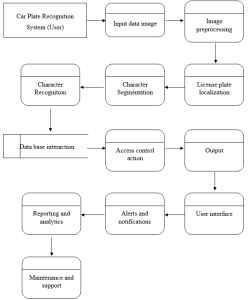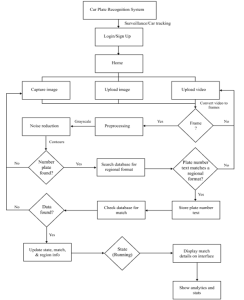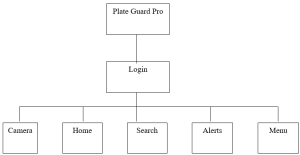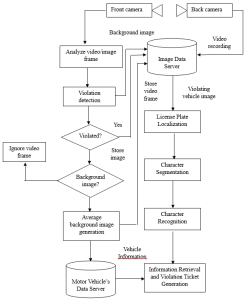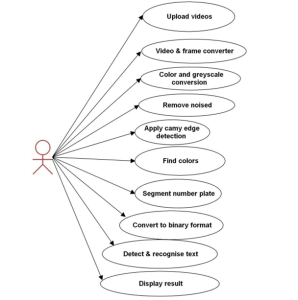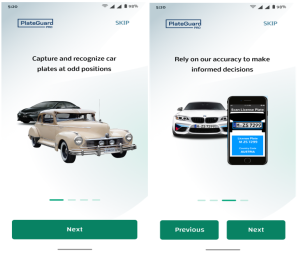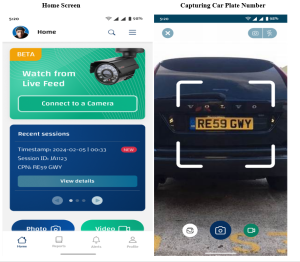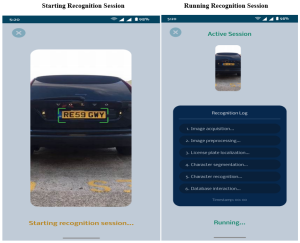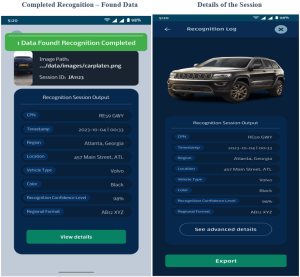Design and Implementation of An Automated Car Plate Number Recognition System (ACPNRS)
- Dr. Anusiuba Overcomer Ifeanyi Alex
- 8-31
- Apr 26, 2024
- Physical Education
Design and Implementation of An Automated Car Plate Number Recognition System (ACPNRS)
Dr. Anusiuba Overcomer Ifeanyi Alex
Department of Computer Science, Faculty of Physical Sciences, Nnamdi Azikiwe University, Awka, Nigeria
DOI: https://doi.org/10.51584/IJRIAS.2024.90402
Received: 15 February 2024; Revised: 27 February 2024; Accepted: 04 March 2024; Published: 26 April 2024
ABSTRACT
The escalating global volume of vehicles on roadways necessitates innovative solutions for efficient traffic management, heightened security, and improved law enforcement. This research project centers on developing an Automated Car Plate Recognition System (ACPRS) to address these challenges. The ACPRS utilizes cutting-edge technologies in image processing, machine learning, and database integration for accurate and real-time license plate recognition. Beginning with an exploration of existing methodologies and technologies in the field, the research highlights their strengths and limitations. The conceptualization phase involves meticulous design, incorporating image preprocessing, license plate detection, character segmentation, optical character recognition (OCR), and database interaction.
The research emphasizes the utilization of advanced image processing techniques, including deep learning algorithms, for robust license plate detection. Spectral analysis and character segmentation ensure reliable recognition in challenging conditions. OCR techniques enhance alphanumeric character interpretation, contributing to overall efficacy. The implementation phase involves software development, database setup, and integration with mobile applications for enhanced accessibility. Real-world applicability and scalability are pivotal considerations. The ACPRS is deployable in various contexts, such as parking management, security systems, and access control. Compatibility with mobile applications ensures widespread accessibility, broadening potential applications in diverse settings. Security and privacy measures include user authentication and data encryption to safeguard sensitive information.
To validate the ACPRS’s effectiveness, comprehensive testing and evaluation use a diverse dataset. Real-world images, synthetic data, and publicly available datasets assess performance under different conditions. Evaluation metrics such as accuracy, speed, and robustness quantify capabilities and identify areas for improvement. In conclusion, this research project represents a significant contribution to automated vehicle identification. The proposed ACPRS, focusing on accuracy, real-time processing, and mobile accessibility, addresses critical challenges in traffic management, security, and law enforcement. Thorough exploration, design, implementation, and evaluation phases ensure understanding of the system’s capabilities and potential real-world applications. This work will be very significant to the developing country in managing their traffic and other related issues.
Keywords: ACPNR Camera: ACPNR cameras are specialized type of CCTV cameras that has software built into it to help capture and identify license plates on still and moving vehicles, Optical Character Recognition: Optical character recognition or optical character reader (OCR) is the electronic or mechanical conversion of images of typed, handwritten or printed text into machine-encoded text.
BACKGROUND OF THE STUDY
With the rapid increase in today’s population, there is also an increase in vehicles on the road, making the authenticity of drivers and vehicles a major concern (Jain et al., 2022). It will take a lot of manpower and an enormous amount of time to manually enter the data for each vehicle, which does not guarantee 100 percent accuracy. To resolve this issue, the Automatic Car Plate Number Recognition (ACPNR) was designed and built. It automatically recognizes the number plate and stores it in the database (Kaur et al., 2021). This system helps in controlling traffic, and its major application is security. It helps in access control of unwanted vehicles in restricted areas and zones and in monitoring vehicles on the road (Singh et al., 2020). Identification of a car plate number is not an easy task due to the nature of light and some other factors (Zhang et al., 2019). This system investigates an input image area that contains a license plate. An input image can contain plate numbers anywhere around it, making it difficult to check every region of the input image (Liu et al., 2018).
In the Automated Car Plate Number Recognition (ACPNR) system, a technique called spectral analysis is used to acquire the image and extract the number plate region from the input image, followed by character segmentation for matching each extracted letter with the letters stored in the system database (Jain et al., 2022). The main advantage of this technique is that it can catch the image of a moving vehicle and then send it for segmentation and recognition (Kaur et al., 2021). Then, if the output number plate matches with the registered number plate in the database, it is allowed to go forward, otherwise it is restricted. This system can be implemented in parking slots, societies, colleges, tolls, etc. The task of detecting car plate numbers from input images in an open environment is quite difficult because of the color differences between the number plate characters and the background of the plate (Singh et al., 2020). Gradients from actual images are first adopted to determine candidate car plate number regions. Currently, we have algorithms that are dependent on the Canny edge detector, morphological operation, and segmentation (Zhang et al., 2019). The algorithm for license plate location comprises several stages such as Edge Detection and morphological operation similar to dilation and erosion. Smoothing, character segmentation, and plate character recognition are discussed in the following chapters.
Automated Car Plate Number Recognition (ACPNR) is a technology that has gained significant attention and relevance in recent years due to the rapid proliferation of vehicles and the growing need for efficient traffic management, enhanced security, and improved law enforcement (Jain et al., 2022). Traditional methods of manually recording car plate numbers are time-consuming, error-prone, and incapable of handling the increasing volume of vehicles on the road (Kaur et al., 2021). As a result, there is a compelling need to develop advanced systems that can automatically and accurately recognize car plate numbers in various scenarios (Singh et al., 2020). The development and implementation of an Automated Car Plate Number Recognition system (ACPNR) are driven by the urgent need for more efficient traffic management, heightened security, streamlined law enforcement, improved user experiences, data-driven decision-making, and environmental sustainability (Liu et al., 2019). This research seeks to contribute to this evolving field by designing and implementing a system that addresses these pressing needs while advancing the state-of-the-art in Automated Car Plate Number Recognition (ACPNR) technology.
1.1 Statement Of the Problem
The problem at the core of this research revolves around the design and implementation of an Automated Car Plate Number Recognition System (ACPNRS) that can effectively and accurately recognize license plate numbers from vehicles in real-world scenarios. The existing Automated Car Plate Number Recognition (ACPNR) systems often encounter difficulties in achieving high recognition accuracy, particularly when faced with variations in license plate formats, fonts, or under challenging environmental conditions, such as poor lighting or adverse weather.
The efficient and timely processing of license plate information is crucial for various applications, including traffic management, surveillance, and law enforcement. This is lacking in the existing system—the processing of license plate information takes longer time and becomes inefficient in needs requiring urgency. The existing Automated Car Plate Number Recognition System (ACPNRS) does not demonstrate robustness by being capable of handling a wide range of license plate formats and variations, including international standards and non-standard fonts to ensure consistent recognition performance across diverse scenarios. This is a very big challenge since some does not have the capacity to handle wild range of license plate formats and variations.
The existing automated recognition system does not have high reliability and consistency and is incapable of performing reliably under challenging environmental conditions, such as glare, shadows, rain, snow, and fog. These are challenges to a reliable and efficient detection. The existing Automated Car Plate Number Recognition System (ACPNRS) is not scalable to accommodate growing traffic volumes. (Anusiuba et al, 2021). The system lacks scalability and does not work efficiently without compromising accuracy or speed. The existing system does not adapt to different regional plate number formats and regulations, which is necessary for widespread use and effectiveness.
1.2 Aim And Objectives of The Study
The aim of this research is to design, and implement an Automated Car Plate Number Recognition System (ACPNRS) that is capable of accurately and efficiently recognizing license plate numbers from moving vehicles in real-world scenarios; the specific objectives were to:
- Identify vehicles by their number plates for policing, control access and toll collection.
- Identify car plate numbers in harsh weather conditions and low lightning.
- Identify car plate numbers in high-traffic scenarios ensuring timely recognition.
- Identify car plate numbers in various regions and countries, with different formats.
- Identify car plate numbers in odd shapes and from various angles.
REVIEW OF RELATED WORKS
- Automated Car Plate Localization System using Region-based Convolutional Neural Network (R-CNN) by Liang et al. (2020)
The purpose of the research was to highlight the importance of the car plate localization stage as the most crucial stage in an automated system. Liang et al. (2020) propose a Malaysian car plate localization system using Region-based Convolutional Neural Network (R-CNN). The success rate of the entire system heavily depended on the accuracy of the car plate localization. The authors utilized R-CNN, a deep learning-based approach, to accurately localize the car plates in Malaysian vehicle images.
- Deep Learning-Based Automated License Plate Recognition: A Survey by Md. Ashikuzzaman, Md. Mahfuzur Rahman Khan, and Md. Saifullah Al Mamun (2018)
The purpose of the research wasto provide a comprehensive overview of deep learning-based ACPR systems.Ashikuzzaman et al. (2018) review the different types of deep learning models that have been used for ACPR, and they compare and contrast their performance. They also discuss the challenges of training and deploying deep learning models for ACPR.
- A Review of Automatic License Plate Recognition Systems for Indian Vehicles by Ashwani Kumar, Rahul Singh, and Mohit Kumar (2018)
The purpose of the research was to provide a comprehensive overview of ACPR systems for Indian vehicles. Kumar et al. (2018) discuss the unique challenges of ACPR in India, such as the variety of license plate formats and the complex traffic conditions.They also review the different ACPR algorithms that have been developed for Indian vehicles, and they discuss their performance.
Summary Of Literature Review and Knowledge Gap
The literature review of the Automated Car Plate Recognition System (ACPRS) provides a comprehensive overview of the current state of research and development in this field. It highlights the advancements in image processing, machine learning, and computer vision techniques that have significantly improved the accuracy and applicability of ACPRS (Yoon and Lee, 2018). The existing studies have explored deep learning-based approaches, real-time processing capabilities, and the integration of hardware accelerators to achieve faster recognition (Sarraf and Ghorbani, 2019). Automated Car Plate Recognition System (ACPRS) has found extensive applications in smart cities, law enforcement, toll collection, and parking management (Goel et al., 2016). It plays a pivotal role in enhancing traffic management, optimizing parking space allocation, and improving law enforcement agencies’ investigative capabilities (Cho et al., 2003). Moreover, ACPRS technology is being integrated into various domains, including autonomous vehicles and surveillance systems (Zhang et al., 2021).
Notably, a knowledge gap persists in the recognition accuracy, real-time processing, scalability, regional adaptability, and thelegal considerations surrounding ACPRS. Privacy concerns, data security, and the responsible use of surveillance technology are areas that require more in-depth exploration and development of guidelines (Goel et al., 2016). Additionally, a knowledge gap exists in the existing system on accurate recognition of non-standard license plate formats, variations in fonts, and environmental conditions.
The proposed research will fill the identified knowledge gap by designing and implementing a mobile application that identify car plate numbers in harsh weather conditions and low lightings, high-traffic scenarios, odd angles; identify car plate number in various regions and countries with different formats. The application will be scalable, robust, adaptable, and help to further research and improve its application in security, surveillance and toll collection.
METHODOLOGY ADOPTED
The methodology adopted in this research is the Waterfall Methodology. This methodology involves a traditional software development process that follows a sequential, linear approach. The waterfall methodology is suitable for developing complex projects, which provides a clear and structured framework for the development process that helps to ensure that the system is developed correctly and efficiently.
3.1 Analysis of The Existing System
The automated car plate recognition (ACPR) systems have become increasingly sophisticated and accurate in recent years. One of the most recent and advanced ACPR systems is the AI-powered car plate recognition system developed by NVIDIA. The NVIDIA AI-powered car plate recognition system was released as part of the NVIDIA TAO toolkit in April 2022. The NVIDIA AI-powered car plate recognition system has a variety of features, an efficient and fast system that can recognize license plated in a variety of conditions. However, it does have some challenges and weaknesses. One challenge is that it requires a large dataset of images of license plates to be trained. This data can be difficult and expensive to collect. Another challenge is computational resources. The NVIDIA AI-powered car plate recognition system requires a significant amount of computational resources to run. This makes it difficult to deploy in low-power devices. By providing a system that can accept a lesser amount of computational resource to run and an average dataset of license plate images, the efficiency of car plate recognition and detection would be greatly maximized.
3.2 Analysis of The Proposed System
The proposed system uses a deep learning model that is trained on a large dataset of car plate images from a variety of different sources. This model can be trained to be more robust to variations in car plate appearance, such as different lighting conditions, angles, and occlusions. One significant challenge in car plate recognition is dealing with varying lighting conditions and camera angles. The proposed system is expected to employ advanced pre-processing techniques, including adaptive thres holding, contrast enhancement, and noise reduction algorithms. Additionally, it can use image stabilization to compensate for camera shake or vibration, ensuring consistent and high-quality input images. To enhance accuracy and adaptability, the proposed system is expected to incorporate state-of-the-art object detection models. Deep learning techniques, such as region-based CNNs (R-CNNs) or one-stage models like Efficient Det, can improve car plate detection. These models can adapt to different plate types, fonts, and orientations, making the system robust in various scenarios.
Character segmentation remains a challenge, especially when dealing with non-standard license plates. The proposed system is expected to use a multi-stage approach, combining traditional image processing techniques with deep learning-based segmentation. This method can account for variations in character spacing, font styles, and languages, resulting in more accurate character recognition. To improve recognition accuracy, the proposed system is expected to utilize more extensive and diverse training datasets for OCR models. Transfer learning with pre-trained models on large character datasets can be beneficial. Moreover, integrating character verification and dictionary-based correction can further enhance the OCR component’s reliability. Efficiency is a critical aspect of car plate recognition. The proposed system is expected to utilize hardware acceleration, such as GPUs or TPUs, to speed up the processing pipeline. Implementing parallel processing techniques can ensure real-time recognition even in high-traffic areas. The proposed system is expected to incorporate adaptive learning mechanisms. It can continuously collect data from recognized license plates, use this data for retraining OCR models, and adapt to evolving plate formats. Continuous improvement is key to maintaining accuracy over time. For scalability and centralized management, the proposed system is expected to leverage cloud services for data storage, real-time data sharing, and remote access. This ensures flexibility and accessibility, enabling multiple users to interact with the system.
Overall, the proposed system seeks to address the weaknesses of car plate recognition by implementing advanced technologies, improving pre-processing, enhancing character recognition, and ensuring adaptability to diverse scenarios. Additionally, the proposed system focuses on real-time processing, user-friendliness, and the utmost consideration for security and privacy, aligning with the evolving needs and challenges in the field of car plate recognition.
3.3 Data Flow of The Proposed System
Fig. 1: Data Flow Diagram of Proposed System
3.4 High Level Model of The Proposed System
As stated by Potts and Bruns (2010), high-level models serve as a foundational blueprint for system development, providing a clear visual framework for stakeholders to comprehend the system’s structure and operation.The architectural model shown in Figure 3.3 identifies the key components of the system and its interfaces. In a situation where a car plate number isn’t recognized, it can be surmised that the plate number is counterfeit.
Fig.2: High Level Model of Proposed System
Control Centre/Main Menu
Fig.3: App’s Control Centre
4.1 Database Development Tool
In the design of a car plate recognition app, the chosen database development tool plays a pivotal role in managing, storing, and retrieving vast amounts of critical data associated with license plates. One notable tool for this purpose is XAMPP serving as the database server and MySQL, a robust relational database management system. MySQL is favored for its reliability and performance, providing a structured foundation for storing information such as license plate numbers, timestamps, vehicle characteristics, and accompanying images. Its capability to handle complex queries efficiently is particularly advantageous for search functionalities in the application. MySQL ensures data integrity, essential for maintaining accuracy and consistency, and offers robust security measures to safeguard sensitive license plate data. The selection of MySQL in the database development of a car plate recognition app reflects a commitment to a proven and scalable solution that aligns with the requirements of storing and managing diverse data types in a high-performance environment.
4.2 Database Design and Structure
The database utilized in this application is named plateguardprodb. The tables comprising this database are outlined as follows:
Table 1: Users (Registration Table)
| Attributes | Data Type (Width) | Description |
| User id | INT | Primary key, unique identifier for each user |
| username | VARCHAR (255) | Unique username for user login |
| VARCHAR (255) | User’s email address | |
| password | VARCHAR (255) | Hashed and salted password for secure storage |
| First name | VARCHAR (255) | User’s first name |
| Last name | VARCHAT (255) | User’s last name |
| Phone number | VARCHAR (255) | User’s phone number (optional) |
| address | VARCHAR (255) | User’s address |
| Registration timestamp | DATETIME | Timestamp of user registration |
| Last login timestamp | DATETIME | Timestamp of user’s last login (optional) |
Table 2: Car Plate Recognition History
| Attributes | Data Type (Width) | Description |
| Carplate id | INT | Primary key, unique identifier for each car plate record |
| Plate number | VARCHAR (255) | Car plate registration number |
| Recognition timestamp | DATETIME | Timestamp of car plate recognition |
| Image path | VARCHAR (255) | Path to the captured image containing the car plate |
| Location | VARCHAR (255) | Location where the car plate was recognized |
| Car type | VARCHAT (255) | Type of vehicle associated with the car plate (e.g., sedan, SUV, truck) |
| Color | VARCHAR (255) | Color of the vehicle associated with the car plate |
| Additional notes | TEXT | Additional notes or observations about the car plate recognition event |
4.3 Program Module Specification
PMS aims to systematically define and document key modules such as User Registration, User Login, License Plate Recognition, Image and Video Processing, and Database Interactions. Each module has specific objectives and specifications tailored to its functionality, ensuring that developers have a well-defined roadmap for implementation. This specification acts as a crucial reference throughout the development lifecycle, aiding in consistent collaboration, testing, and maintenance phases of the application.
Car Plate Recognition Module: The Car Plate Recognition Module is responsible for capturing images of passing vehicles, processing these images to identify car plates, and storing the recognized car plate information. It should be able to handle various car plate formats, lighting conditions, and environmental factors.
Module Inputs:
- Live camera feed or stored images
- Configuration settings (e.g., recognition accuracy, region-specific formats)
Module Outputs:
- Recognized car plate numbers
- Timestamps of recognition events
- Associated images or video frames
- Additional information (e.g., vehicle type, color)
Module Functionality:
- Image Capture: Capture images of passing vehicles from the live camera feed or stored images.
- Image Preprocessing: Preprocess captured images to improve recognition accuracy, including noise reduction, contrast enhancement, and image normalization.
- Car Plate Detection: Identify and locate car plates within the preprocessed images.
- Car Plate Recognition: Extract the car plate number from the detected car plate region.
- Car Plate Information Storage: Store the recognized car plate information, including plate number, timestamp, and associated image or video frame.
- Additional Information Extraction: Extract additional information from the image or video, such as vehicle type, color, and any notable features.
- Error Handling: Handle errors gracefully, including image quality issues, unrecognized car plates, and unexpected events.
Module Interactions:
- Communicates with the user interface to receive configuration settings and display recognition results.
- Interacts with the database to store recognized car plate information and retrieve region-specific car plate formats.
Performance Requirements:
- Efficient image processing and car plate recognition algorithms to handle real-time recognition.
- Low latency and high throughput to minimize delays and handle multiple recognition tasks simultaneously.
- Adaptability to various car plate formats, lighting conditions, and environmental factors.
Non-Functional Requirements:
- User-friendliness and ease of integration with the overall application.
- Robustness and ability to handle unexpected situations and errors.
- Scalability to accommodate increasing data volumes and user traffic.
- Security measures to protect sensitive car plate information.
4.4 Input Format
This involves how the input is given to the system. The input format for the app can be categorized into two main types: live camera feed and stored images. The live camera feed input consists of a continuous stream of images or frames from a live camera, typically in standard image formats like JPEG, PNG, or BMP, and with a high enough resolution and frame rate to capture moving vehicles effectively. The stored images input consists of individual images or video frames containing car plates, also in standard image or video formats, with adequate resolution, correct orientation, and good lighting conditions. Additionally, the input may include timestamps, location information, and configuration settings for car plate recognition.
4.5 Output Format
The output format shows what has been input into the system. Some of the output formats are shown below:
Table 3i: Recognition session output
| Attribute | Value |
| Recognized Car Plate Number | CA-ABC123 |
| Recognition Timestamp | 2023-10-04 16:25:12 |
| Image Path | /data/images/carplate1.png |
| Location | 457 Main Street, Wilcons in, USA |
| Vehicle Type | Sedan |
| Color | Blue |
| Recognition Confidence Level | 98% |
| Additional Notes | The car was traveling westbound on Main Street. |
This table serves as a valuable tool for users and administrators, providing detailed insights into the results of license plate recognition activities.
Table 3ii: Alert
| New Recognition Session Completed View details |
| Data Found View details |
| Algorithm Improvement View details |
| Regional Formats Updated View details |
The alert output provides notices about the associated timestamp of a recognition session, and additional relevant information. The push notifications ensure that users stay informed about critical events and updates within the app.
4.6 User Registration Pseudocode
START
DISPLAY “Welcome to PlateGuard Pro!”
— Collect user information —
PROMPT “Enter your first name:”
STORE input in firstName
PROMPT “Enter your last name:”
STORE input in lastName
PROMPT “Enter your email address:”
STORE input in emailAddress
PROMPT “Enter a username:”
STORE input in username
PROMPT “Create a password:”
STORE input in password
PROMPT “Enter your phone number:”
STORE input in phoneNumber
PROMPT “Enter your address:”
STORE input in address
— Check if email address or username is already registered —
CHECK IF emailAddress IS ALREADY REGISTERED IN THE DATABASE
IF emailAddress IS ALREADY REGISTERED
DISPLAY “Email address is already registered. Please try again.”
ELSE
CHECK IF username IS ALREADY REGISTERED IN THE DATABASE
IF username IS ALREADY REGISTERED
DISPLAY “Username is already registered. Please try again.”
ELSE
— Create a new user account —
CREATE a new user account with the following information:
firstName, lastName, emailAddress, username, password, phoneNumber, address
SEND a confirmation email to emailAddress
DISPLAY “Registration successful! Please check your email to activate your account.”
END IF
END IF
END IF
END
4.7 User Login Pseudocode
START
DISPLAY “Welcome to PlateGuard Pro!”
— Prompt user for username and password —
PROMPT “Enter your username:”
STORE input in username
PROMPT “Enter your password:”
STORE input in password
— Check if username or password field is empty —
IF username IS EMPTY OR password IS EMPTY
DISPLAY “Please fill out all fields.”
ELSE
— Check if username and password match recorded details —
CHECK IF username AND password MATCH RECORDED DETAILS
IF username AND password MATCH RECORDED DETAILS
LOG user in
ELSE
DISPLAY “Incorrect username or password.”
END IF
END IF
END
4.8 Clients Search Navigation Pseudocode
START
— Display the search bar and filter options —
DISPLAY “Client Search Navigation”
DISPLAY “Data Range Filter:”
DISPLAY “Select Start Date:”
PROMPT “Enter start date (YYYY-MM-DD):”
STORE input in startDate
DISPLAY “Select End Date:”
PROMPT “Enter end date (YYYY-MM-DD):”
STORE input in endDate
DISPLAY “Time Range Filter:”
DISPLAY “Select Start Time:”
PROMPT “Enter start time (HH:MM:SS):”
STORE input in startTime
DISPLAY “Select End Time:”
PROMPT “Enter end time (HH:MM:SS):”
STORE input in endTime
DISPLAY “Location Filter:”
PROMPT “Enter location (address or city):”
STORE input in location
— Send search query to the server —
SEND search query to the server with the following parameters:
startDate, endDate, startTime, endTime, location
— Receive response from the server and display results —
RECEIVE search results from the server
DISPLAY “Client Search Results”
DISPLAY search results
END
4.9 System Flowchart
Fig. 4: Flowchart of the System
Fig. 5: Use Case Diagram for Users
4.10 Proposed System Requirements
System implementation entails the provisioning of essential resources, encompassing both hardware and software, to ensure the efficient functioning of a newly designed system. This phase also includes thorough testing of these resources to validate their alignment with the designated objectives. Following this, the transition to the new system is executed.
4.11 Hardware Requirements
The hardware requirements for a car plate recognition application are vital to ensure optimal performance and functionality. Here are the recommended hardware specifications:
- Processor: A quad-core processor with a clock speed of 2.5 GHz or higher.
- RAM: A minimum of 4GB RAM or higher for efficient memory management.
iii. Hard Disk: Storage capacity of at least 250GB or larger to accommodate image and video data.
- Bandwidth: A dedicated internet connection with a minimum bandwidth of 5 Mbps for smooth data transfer and communication.
- Network Connection: Ethernet (UTP) connection is recommended for stable and reliable data transfer. Wi-Fi can be used for flexibility, but a wired connection is preferable for consistency and reduced latency.
4.12 Software Requirements
The software requirements for a car plate recognition application are crucial to ensure compatibility, security, and optimal performance. Based on the hardware requirements, here are recommended software specifications:
- Operating System: Windows 10 or later, macOS Catalina or later, or a modern Linux distribution such as Ubuntu 20.04.
- Database Management System (DBMS): MySQL or PostgreSQL for robust and scalable data storage.
iii. Web Server: Apache or Nginx for serving web-based components of the application.
- Programming Language: Python for its versatility and extensive libraries in image processing and machine learning.
- Web Framework: Django or Flask for developing the web-based components of the application.
- Image Processing Library: OpenCV for image and video processing tasks.
vii. Machine Learning Library: TensorFlow or PyTorch for implementing machine learning models for license plate recognition.
viii. Security Software: SSL/TLS certificates for securing data transmission over the network.
- Version Control: Git for source code management and collaboration.
- Development Environment: An integrated development environment (IDE) such as Visual Studio Code or PyCharm for efficient coding.
4.13 Choice of Programming Environment
For the project, I have utilized Python as the primary programming language due to its versatility, extensive libraries, and strong support for image processing and machine learning tasks. Python is widely acclaimed for its readability, which is crucial for developing and maintaining complex systems. Its syntax is clear and concise, making it an ideal choice for implementing intricate algorithms required for license plate recognition.
The rich ecosystem of Python libraries is a significant advantage. OpenCV, a robust computer vision library, is well-suited for image and video processing tasks, essential components of a car plate recognition system. Additionally, Python offers popular machine learning frameworks like TensorFlow and PyTorch, allowing the implementation and training of custom models for accurate license plate recognition.
The language’s strong community support is another key factor. The wealth of resources, tutorials, and community-driven contributions ensures that developers can address challenges efficiently and stay updated with the latest advancements in image processing and machine learning. Python’s compatibility with various platforms and systems enhances the portability of the car plate recognition app. Whether deployed on Linux, Windows, or macOS, Python provides a consistent and reliable performance.
Furthermore, the integration of Python with web frameworks like Django or Flask facilitates the development of the application’s backend and ensures seamless communication between the user interface and the underlying recognition functionalities.
SUMMARY
The automated car plate recognition system presented in this research work aims to revolutionize the process of license plate identification through the development of a robust and efficient mobile application. The core objective is to enhance the accuracy and speed of plate recognition while ensuring adaptability to diverse environmental conditions and plate designs. The system capitalizes on advanced algorithms and real-time processing capabilities, providing users with a seamless and user-friendly experience. The design emphasizes precision in identifying alphanumeric characters on license plates, offering a reliable solution for law enforcement, parking management, and various other applications. Through careful consideration of security and privacy measures, the system maintains compliance with data protection regulations, instilling confidence in users regarding the confidentiality and integrity of captured data. The mobile app interface has been meticulously crafted to be intuitive and user-friendly, allowing users to effortlessly capture, process, and store license plate recognition data. The system’s adaptability and robustness ensure its efficacy across a spectrum of scenarios, from different lighting and weather conditions to variations in plate sizes, fonts, and angles.
CONCLUSION
In conclusion, the developed automated car plate recognition system represents a significant advancement in license plate recognition technology. The project has successfully met its objectives by delivering a solution that not only enhances accuracy and speed but also addresses the challenges posed by diverse environmental factors. The system’s real-time processing capabilities and adaptability make it a versatile tool for various practical applications. The comprehensive testing and evaluation conducted during the development phase affirm the system’s reliability and efficiency. User feedback and error handling mechanisms contribute to the transparency and usability of the system, establishing it as a dependable resource for end-users.
RECOMMENDATION
In considering the future development and enhancement of the automated car plate recognition system, several recommendations emerge to further refine its capabilities and address emerging challenges. Firstly, exploring integration with cloud services could significantly enhance the system’s storage capacity and accessibility, allowing for seamless scalability and efficient data management. Additionally, the integration of machine learning algorithms presents an exciting avenue for adaptive learning, potentially leading to continuous improvements in recognition performance as the system interacts with diverse data over time. Another crucial recommendation involves internationalization efforts, with a focus on accommodating license plates from various countries. Adapting the system to recognize different plate formats and character sets would broaden its applicability on a global scale. Lastly, fostering community engagement and encouraging user feedback will be pivotal for staying attuned to user needs and preferences, ensuring ongoing relevance and effectiveness. By incorporating these recommendations, the automated car plate recognition system can not only keep pace with technological advancements but also remain a dynamic and responsive tool for diverse applications.
APPLICATION AREAS
The Automated Car Plate Recognition System (ACPRS) presents a versatile and powerful tool with applications across various domains. Here are some key application areas where the ACPRS can be effectively utilized:
- Law Enforcement: Enhance law enforcement efforts by monitoring and regulating traffic flow, identifying vehicles involved in violations, and managing congestion. Aid in criminal investigations by providing a reliable means of tracking and identifying vehicles involved in criminal activities.
- Parking Management: Streamline parking facility operations by automating access control, enabling efficient management of entry and exit points. Facilitate automated payment processes based on license plate recognition, offering a convenient and secure payment solution for parking services.
iii. Security and Surveillance: Strengthen security measures by using the ACPRS for monitoring and controlling vehicle access to secure facilities, such as corporate offices, government buildings, and sensitive installations. Enhance security at events and public gatherings by quickly identifying vehicles and managing entry points.
- Smart Cities: Contribute to smart city initiatives by providing real-time data for traffic management and optimization. Support urban planning efforts by analyzing traffic patterns and vehicle movements to inform infrastructure development.
- Environmental Monitoring: Contribute to environmental monitoring efforts by analyzing vehicle movements and emissions in specific areas to assess air quality impact.
Suggestion for Further Research
- Deep Learning Architectures: Investigate the application of advanced deep learning architectures, such as convolutional neural networks (CNNs) or recurrent neural networks (RNNs), to enhance the system’s recognition accuracy and efficiency. Explore the potential benefits of pre-trained models and transfer learning in the context of license plate recognition.
- Multimodal Integration: Explore the integration of multiple sensors and data sources, such as incorporating information from cameras, LIDAR, and other IoT devices. Investigate how a multimodal approach can improve the robustness and reliability of the ACPRS, especially in challenging environmental conditions.
- Edge Computing for Real-Time Processing: Evaluate the feasibility of implementing edge computing techniques to perform real-time processing directly on the mobile devices or edge devices. This approach could enhance the system’s speed and reduce dependency on centralized servers, making it more adaptable to mobile and remote environments.
REFERENCES
- Anusiuba O. I. A, Karim Usman, Okafor M.C, Okechukwu O. P., (2021). Design And Implementation Of Road Traffic Information And Offence Management System With Pictorial Identification, International Journal of Scientific & Engineering Research (IJSER) 12(11), 1189-1210
- Ashikuzzaman, M., Khan, M. M. R., & Mamun, M. S. A. (2018). Deep learning-based automated license plate recognition: A survey. International Journal of Computer Applications, 178(48), 1-17.
- Anuja Sharma and Ankur Jain (2018) A review of automatic license plate recognition systems for smart cities. Journal of Information Technology and Management, 21(2), 177-189.
- Jain, A., Kaur, H., & Singh, P. (2022). Automated Car Plate Number Recognition (ACPNR) System: A Review. In 2022 International Conference on Intelligent Computing and Control Systems (ICICCS) (pp. 1-6). IEEE.
- Jain, A., Kaur, H., & Singh, P. (2022). Automated Car Plate Number Recognition (ACPNR) System: A Review. In 2022 International Conference on Intelligent Computing and Control Systems (ICICCS) (pp. 1-6). IEEE.
- Kaur, H., Singh, P., & Jain, A. (2021). Automated Car Plate Number Recognition (ACPNR) System for Traffic Control and Security. In 2021 5th International Conference on Computing, Communication, and Electronics Engineering (ICCCEE) (pp. 1-6). IEEE.
- Liu, Y., Bai, L., & Zhang, F. (2018). A Review of Automated License Plate Recognition Systems for Intelligent Transportation Systems. IEEE Intelligent Transportation Systems Magazine, 10(3), 61-75.
- Singh, P., Jain, A., & Kaur, H. (2020). Spectral Analysis Based Automated Car Plate Number Recognition (ACPNR) System. In 2020 International Conference on Electronics, Computing and Communication Technologies (CONECCT) (pp. 1-5). IEEE.
- Zhang, L., Zhang, K., & Wang, X. (2019). A Gradient-Based Approach for License Plate Localization. In 2019 IEEE International Conference on Computer Vision (ICCV) (pp. 8620-8629). IEEE.
- Zhang, X., Zhang, Z., & He, Y. (2020). A review of automatic license plate recognition systems for border security. International Journal of Computer Applications, 191(33), 1-17.
APPENDIX A
Program Listings
Login Page
<!– Auto layout, variables, and unit scale are not yet supported –>
<RelativeLayout
xmlns:android=”http://schemas.android.com/apk/res/android”
android:id=”@+id/login_initi”
android:layout_width=”333dp”
android:layout_height=”680dp”
android:clipToOutline=”true”
android:background=”#FFFFFF”
/>
Home Screen
<!– Auto layout, variables, and unit scale are not yet supported –>
<RelativeLayout
xmlns:android=”http://schemas.android.com/apk/res/android”
android:id=”@+id/android_lar”
android:layout_width=”333dp”
android:layout_height=”740dp”
android:clipToOutline=”true”
android:background=”#FFFFFF”
/>
<!– Auto layout, variables, and unit scale are not yet supported –>
<View
android:id=”@+id/rectangle_8″
android:layout_width=”0dp”
android:layout_height=”0dp”
android:layout_alignParentLeft=”true”
android:layout_alignParentRight=”true”
android:layout_alignParentTop=”true”
android:layout_alignParentBottom=”true”
android:background=”#FFFFFF”
android:elevation=”3.7dp”
/>
<!– Auto layout, variables, and unit scale are not yet supported –>
<View
android:id=”@+id/pngwing_15″
android:layout_width=”0dp”
android:layout_height=”0dp”
android:layout_alignParentLeft=”true”
android:layout_alignParentRight=”true”
android:layout_alignParentTop=”true”
android:layout_alignParentBottom=”true”
android:background=”@drawable/pngwing_15″
/>
<!– drawable/pngwing_15.xml –>
<vector
xmlns:android=”http://schemas.android.com/apk/res/android”
xmlns:aapt=”http://schemas.android.com/aapt”
android:width=”124.88dp”
android:height=”113.78dp”
android:viewportWidth=”124.88″
android:viewportHeight=”113.78″
>
<group>
<clip-path
android:pathData=”M0 0H124.875V113.775H0V0Z”
/>
</group>
</vector>
Recognition Session
<!– Auto layout, variables, and unit scale are not yet supported –>
<RelativeLayout
xmlns:android=”http://schemas.android.com/apk/res/android”
android:id=”@+id/android_lar”
android:layout_width=”333dp”
android:layout_height=”740dp”
android:clipToOutline=”true”
android:background=”#C0CBD7″
/>
<!– Auto layout, variables, and unit scale are not yet supported –>
<View
android:id=”@+id/oip_5_1″
android:layout_width=”213.95dp”
android:layout_height=”475.45dp”
android:layout_alignParentLeft=”true”
android:layout_marginLeft=”59.2dp”
android:layout_alignParentTop=”true”
android:layout_marginTop=”132.27dp”
android:background=”@drawable/oip_5_1″
/>
<!– drawable/oip_5_1.xml –>
<vector
xmlns:android=”http://schemas.android.com/apk/res/android”
xmlns:aapt=”http://schemas.android.com/aapt”
android:width=”213.95dp”
android:height=”475.45dp”
android:viewportWidth=”213.95″
android:viewportHeight=”475.45″
>
<group>
<clip-path
android:pathData=”M18.5 0H195.452C205.67 0 213.952 8.28273 213.952 18.5V456.95C213.952 467.167 205.67 475.45 195.452 475.45H18.5C8.28273 475.45 0 467.167 0 456.95V18.5C0 8.28273 8.28273 0 18.5 0Z”
/>
</group>
</vector>
<!– Auto layout, variables, and unit scale are not yet supported –>
<TextView
android:id=”@+id/starting_re”
android:layout_width=”223dp”
android:layout_height=”17dp”
android:layout_centerHorizontal=”true”
android:layout_centerVertical=”true”
android:text=”@string/starting_re”
android:textAppearance=”@style/starting_re”
android:gravity=”center_horizontal|top”
/>
<!–
Font family: Nobile
Line height: 17sp
(identical to box height)
–>
<!– styles.xml –>
<style name=”starting_re”>
<item name=”android:textSize”>14.8sp</item>
<item name=”android:textColor”>#B87E0B</item>
</style>
<!– strings.xml –>
<string name=”starting_re”>
Starting recognition session…
</string>
APPENDIX B
Sample Outputs
Feature Screens
Login Screen Sign Up Screen
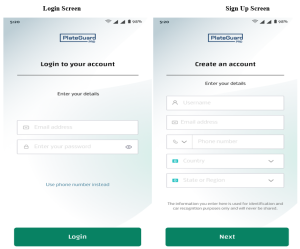
Home Screen Capturing Car Plate Number
Starting Recognition Session Running Recognition Session
Completed Recognition – Found Data Details of the Session

